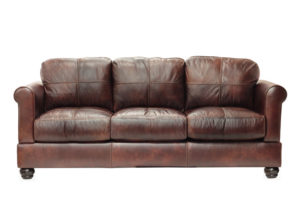Foam density is a specific measurement of how much weight in pounds polyurethane foam can handle per cubic foot. This density rating tells you the strength of the foam.
Cushion construction is the single most important factor in determining the lifespan (and comfort) of your sofa, couch or chair.

There are three basic types of cushion construction for most couches and sofas sold in the U.S.
- Foam
- Coil springs
- Down/feathers
Many cushions are made using a combination of two or all three of these various constructions.
Foam is the most commonly sold cushion construction. It is available in several different densities.
Each foam density is available in a wide variety of different firmnesses.
- Although most people think that density and firmness are synonymous they are actually very different.
- Most foam suppliers typically stock 4-5 commonly used densities for residential furniture seat cushions ranging from 1.5 to 2.5. The number designates the weight (in pounds) of 1 cubic ft. of foam.
- Each of these different densities may be available in 10 or more different firmnesses ranging from very soft to very firm.
The expected lifespan of a foam cushion is primarily dependent on the density and thickness of the foam.
Another important factor is whether the foam is HR (High Resiliency) which recovers its shape better after use.
The frequency of use and the size of the people using the cushion will also affect a seat cushion’s lifespan.
A foam cushion’s “firmness” has very little effect on the expected lifespan.
- Since most consumers equate “firmness” with durability, cheap foams are often made “extra firm.” With a low density foam, however, that “extra firm” feeling will not last long.
- Occasionally there will be an inner core of heavier density foam with an outer core of lighter density foam. When this happens the manufacturer or retailer may describe the foam using the heavier density only.
The most common density used by far for mid-priced residential furn iture is 1.8.
- Depending on the thickness of the foam, whether or not it is HR (High Resilience) and how much use the couch gets, a 1.8 density cushion will typically begin to lose its shape and resilience within one year.
- After 3–5 years a 1.8 density cushion will usually need to be replaced. Since replacing cushions is often not simple or cheap many people choose to purchase another sofa when their cushions wear out.
- Lower density foams are typically used for back cushions or padding that goes over the arms or other parts of the frame.
- Higher densities (2.2 – 2.5) can be found on more expensive residential furniture. Thinner cushions (or composite cushions using more than one foam density) may use densities as high as 2.8.
- Composite cushions may use multiple foam layers with a firm high density inner core and softer low density outer core(s).
- Furniture designed for heavy commercial or institutional use may use foam with densities of 3.0 or higher.
The higher the foam density the more the cushion will cost. Variations in firmness usually do not affect cost.
HR (High Resiliency) foam is more expensive (and more durable) than non-HR foams.
The most commonly used foam density for residential furniture sold in the U.S. is 1.8.
The term “High Density Foam” is almost meaningless. It is used in marketing materials to describe virtually any foam from 1.8 density foam and up.
In most cases when a foam is described only as “high density” with no number it is a 1.8 density foam.
The foam core is usually anywhere from 4″ – 6″ thick and is typically wrapped in a dacron polyester fiber. The wrapping may consist of a layer of memory foam in place of the dacron polyester.
The fiber (or memory foam) wrapping is generally 0.5 – 1.0″ thick on the top and bottom of the cushion. It softens the feel of the cushion but has no effect on lifespan.
A 4″ thick foam core made with 1.8 density HR (High Resiliency) foam can be expected to begin losing its firmness and ability to “bounce back” in less than 1 year and need replacement 1 – 2 years later with average use.
A 5″ thick foam core made with 1.8 density HR (High Resiliency) foam will also begin to lose its firmness and resilience within one year, but will typically have an additional 2 – 4 years lifespan with average use before the foam will need replacement.
High Resilency (HR) foam cushions will typically still be usable for another several years after the deterioration process begins. Foams that are not HR will deteriorate more rapidly.
Actual foam densities will vary during the manufacturing process. A variation of 0.1 is considered normal. A 1.8 density foam may actually be 1.7 or 1.9. Larger variations are not unusual.
There are many couches sold with cheaper (and lighter weight) 1.5 density foam that will deteriorate even more rapidly, sometimes within one year of purchase.
The overall thickness of the cushion may or may not be an indication of a cushion’s durability.
“Value priced” couches will sometimes have cushions that are bulked up with several inches of polyester fiber around the foam core.
That polyester fiber will rapidly compress causing the cushion to lose its shape. Better quality sofas typically use 0.5″ – 1.0″ of fiber on each side of the cushion.
Lower quality couches may use up to 3″ of fiber on each side. Thick layers of fiber are a cheap way to bulk up a cushion over the short term. Thick fiber quickly compresses and causes the cushion to lose its shape – often within one year.
Another way to bulk up a cushion to make it look more expensive is to use a low density foam (typically 1.2 density) around a firmer inner foam core. This is superior to artificially bulking up the cushion using the polyester fiber.
If you want to get more than 5 years of use from your couch you will need to find a couch with a better quality cushion.
Higher priced couches generally use thick higher density, HR (high resiliency) foams with at least a 2.0 density. but preferably higher.
Cushions fabricated with good quality coil spring construction will usually have a lifespan as long (or longer) than the best (highest density) foams.
There is virtually no way to tell what type of foam is used inside non-removable cushions. It is rarely cost effective to replace the foam inside a non-removable cushion.
When shopping for a couch always test the cushions by picking them up. As a general rule if the seat cushions feel “light” you are looking at a couch with a very short expected lifespan.
Know someone who might be interested in this post? Please like and share this post with them. If you have questions or comments please leave them below. Shopping for furniture can be complex and frustrating. Salespeople often do not have enough knowledge to answer your questions or give advice based on limited experience. Take this opportunity to get real information and advice before spending hundreds or thousands of dollars.

Great information. I’m ready to go shopping